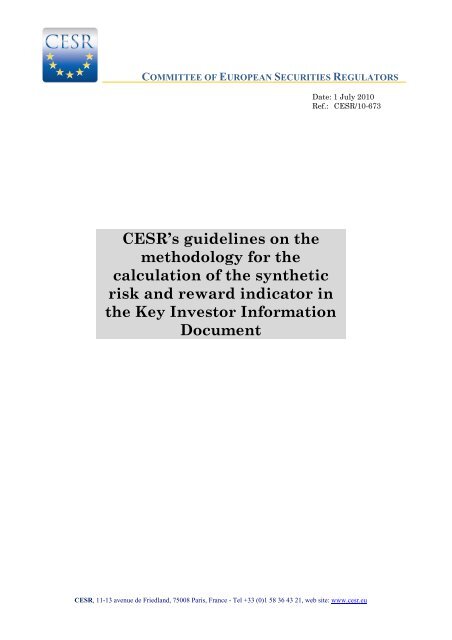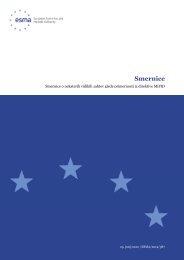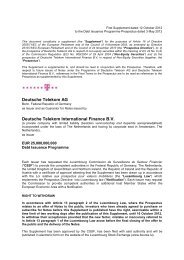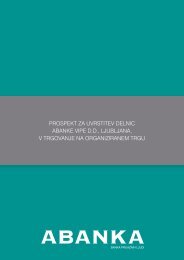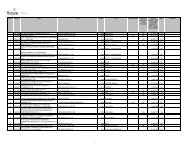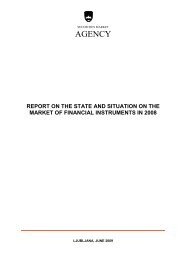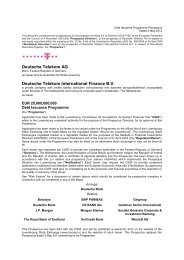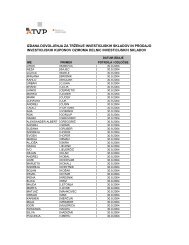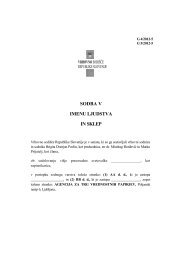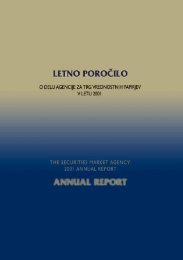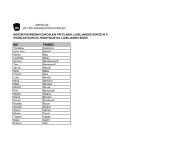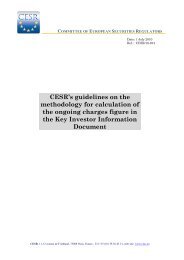CESR's guidelines on the methodology for the calculation of ... - Esma
CESR's guidelines on the methodology for the calculation of ... - Esma
CESR's guidelines on the methodology for the calculation of ... - Esma
You also want an ePaper? Increase the reach of your titles
YUMPU automatically turns print PDFs into web optimized ePapers that Google loves.
COMMITTEE OF EUROPEAN SECURITIES REGULATORS<br />
Date: 1 July 2010<br />
Ref.: CESR/10-673<br />
CESR’s <str<strong>on</strong>g>guidelines</str<strong>on</strong>g> <strong>on</strong> <strong>the</strong><br />
<strong>methodology</strong> <strong>for</strong> <strong>the</strong><br />
calculati<strong>on</strong> <strong>of</strong> <strong>the</strong> syn<strong>the</strong>tic<br />
risk and reward indicator in<br />
<strong>the</strong> Key Investor In<strong>for</strong>mati<strong>on</strong><br />
Document<br />
CESR, 11-13 avenue de Friedland, 75008 Paris, France - Tel +33 (0)1 58 36 43 21, web site: www.cesr.eu
Executive Summary<br />
1. CESR delivered its advice to <strong>the</strong> European Commissi<strong>on</strong> <strong>on</strong> <strong>the</strong> <strong>for</strong>mat and c<strong>on</strong>tent <strong>of</strong> Key<br />
In<strong>for</strong>mati<strong>on</strong> Document disclosures in October 2009 (Ref. CESR/09-949). That advice was<br />
supplemented by two detailed technical methodologies <strong>on</strong> <strong>the</strong> risk and reward indicator (Ref.<br />
CESR/09-1026) and <strong>the</strong> <strong>on</strong>going charges figure (Ref. CESR/09-1028) that were delivered in<br />
December 2009. The Commissi<strong>on</strong> has indicated that it sees <strong>the</strong>se methodologies as being more<br />
appropriately adopted via binding technical standards by <strong>the</strong> new European Securities and<br />
Markets Authority (ESMA) ra<strong>the</strong>r than as level 2 implementing measures. During <strong>the</strong> period<br />
leading up to <strong>the</strong> establishment <strong>of</strong> ESMA, CESR has agreed to adopt <strong>the</strong> methodologies as level 3<br />
<str<strong>on</strong>g>guidelines</str<strong>on</strong>g> in order to provide clarity to <strong>the</strong> industry in implementing <strong>the</strong> new package <strong>of</strong> UCITS<br />
requirements.<br />
2. The <strong>methodology</strong> <strong>for</strong> <strong>the</strong> syn<strong>the</strong>tic risk and reward indicator (SRRI) set out in <strong>the</strong>se <str<strong>on</strong>g>guidelines</str<strong>on</strong>g><br />
applies to all UCITS. It should be based <strong>on</strong> <strong>the</strong> volatility <strong>of</strong> <strong>the</strong> fund using weekly or m<strong>on</strong>thly<br />
returns covering <strong>the</strong> previous five years. In light <strong>of</strong> <strong>the</strong> outcome <strong>of</strong> <strong>the</strong> volatility calculati<strong>on</strong>, <strong>the</strong><br />
UCITS should be assigned to <strong>the</strong> appropriate category <strong>on</strong> a numerical scale <strong>of</strong> 1 to 7. The<br />
<strong>methodology</strong> sets out how <strong>the</strong> volatility intervals should be defined as well as detailed rules <strong>on</strong><br />
how to assess migrati<strong>on</strong>s. There are specific rules <strong>on</strong> applicati<strong>on</strong> <strong>of</strong> <strong>the</strong> <strong>methodology</strong> to absolute<br />
return funds, total return funds, life cycle funds and structured funds. In <strong>the</strong> latter case, <strong>the</strong><br />
SRRI should be calculated <strong>on</strong> <strong>the</strong> basis <strong>of</strong> <strong>the</strong> annualized volatility corresp<strong>on</strong>ding to <strong>the</strong> 99%<br />
Value at Risk (VaR) at maturity.<br />
2
Background and introducti<strong>on</strong><br />
1. In its technical advice to <strong>the</strong> European Commissi<strong>on</strong> <strong>on</strong> <strong>the</strong> Key In<strong>for</strong>mati<strong>on</strong> Document <strong>for</strong><br />
UCITS (CESR/09-949), published <strong>on</strong> 28 October 2009 (hereafter <strong>the</strong> Advice), CESR proposed <strong>the</strong><br />
use <strong>of</strong> a syn<strong>the</strong>tic indicator (hereafter <strong>the</strong> SRRI) <strong>for</strong> funds’ risk and reward disclosure,<br />
accompanied by a short narrative descripti<strong>on</strong> <strong>of</strong> <strong>the</strong> limitati<strong>on</strong>s <strong>of</strong> <strong>the</strong> indicator and, where<br />
relevant, <strong>the</strong> risks that are not fully captured by <strong>the</strong> indicator.<br />
2. In order to reach this c<strong>on</strong>clusi<strong>on</strong>, CESR c<strong>on</strong>sulted twice with external stakeholders, during <strong>the</strong><br />
spring (March) and over <strong>the</strong> summer (August and early September) <strong>of</strong> 2009, and took into<br />
account, inter alia, <strong>the</strong> findings from <strong>the</strong> Commissi<strong>on</strong>’s testing exercise. In particular, <strong>the</strong> testing<br />
revealed that investors have a str<strong>on</strong>g preference <strong>for</strong> <strong>the</strong> inclusi<strong>on</strong> <strong>of</strong> a syn<strong>the</strong>tic indicator in <strong>the</strong><br />
Key Investor In<strong>for</strong>mati<strong>on</strong> Document (KID), and that <strong>the</strong>y seem to be more c<strong>on</strong>fident in <strong>the</strong>ir<br />
ability to compare funds and assess <strong>the</strong>ir level <strong>of</strong> risk when <strong>the</strong>y are provided with an indicator<br />
based <strong>on</strong> a numerical scale.<br />
3. However, CESR also acknowledged that a move towards <strong>the</strong> inclusi<strong>on</strong> <strong>of</strong> a syn<strong>the</strong>tic risk and<br />
reward indicator requires agreement <strong>on</strong> <strong>the</strong> methodological elements underlying <strong>the</strong> calculati<strong>on</strong><br />
<strong>of</strong> such an indicator. This will ensure that all UCITS funds are classified into <strong>the</strong> risk and<br />
reward scale according to <strong>the</strong> same criteria throughout <strong>the</strong> European Uni<strong>on</strong>.<br />
4. CESR <strong>the</strong>re<strong>for</strong>e developed a detailed <strong>methodology</strong> <strong>for</strong> <strong>the</strong> computati<strong>on</strong> <strong>of</strong> <strong>the</strong> SRRI, which it<br />
submitted to <strong>the</strong> Commissi<strong>on</strong> in December 2009 (Ref. CESR/09-1026). In <strong>the</strong> <strong>for</strong>mulati<strong>on</strong> <strong>of</strong> its<br />
proposal, CESR benefited from <strong>the</strong> work <strong>of</strong> both regulators and industry representatives. CESR<br />
also published a feedback statement setting out how <strong>the</strong> resp<strong>on</strong>ses to <strong>the</strong> c<strong>on</strong>sultati<strong>on</strong> had been<br />
reflected in <strong>the</strong> advice (Ref. CESR/09-995).<br />
5. The <strong>methodology</strong> was tailored to cover <strong>the</strong> particular features <strong>of</strong> <strong>the</strong> different types <strong>of</strong> fund and,<br />
in particular, to satisfy <strong>the</strong> following criteria and objectives:<br />
• provide investors with a meaningful indicati<strong>on</strong> <strong>of</strong> <strong>the</strong> overall risk and reward pr<strong>of</strong>ile <strong>of</strong> <strong>the</strong><br />
UCITS;<br />
• ensure an appropriate spread <strong>of</strong> UCITS across different risk classes;<br />
• be applicable to all types <strong>of</strong> UCITS;<br />
• leave no room <strong>for</strong> manipulati<strong>on</strong>;<br />
• enable easy and cost-effective implementati<strong>on</strong> by UCITS providers;<br />
• be easily understood by auditors, advisers and distributors;<br />
• enable easy and effective supervisi<strong>on</strong> by regulators; and<br />
• achieve an adequate degree <strong>of</strong> stability in <strong>the</strong> risk classificati<strong>on</strong> process with respect to<br />
normal trends and fluctuati<strong>on</strong>s <strong>of</strong> financial markets.<br />
6. Following submissi<strong>on</strong> <strong>of</strong> CESR’s advice, <strong>the</strong> European Commissi<strong>on</strong> began work to prepare <strong>the</strong><br />
level 2 implementing measures that would support <strong>the</strong> requirements <strong>of</strong> <strong>the</strong> revised UCITS<br />
Directive (2009/65/EC) at level 1. The advice that CESR submitted <strong>on</strong> risk and reward<br />
disclosure – in particular Secti<strong>on</strong> 4 <strong>of</strong> Ref. CESR/09-949 – was incorporated into <strong>the</strong> level 2<br />
3
implementing measures without any substantive changes to <strong>the</strong> c<strong>on</strong>tent. This is reflected in<br />
Articles 8 to 9, 29, 32 and Annex II <strong>of</strong> <strong>the</strong> KII implementing Regulati<strong>on</strong> 1 .<br />
7. During <strong>the</strong> preparati<strong>on</strong> <strong>of</strong> <strong>the</strong> implementing measures, <strong>the</strong> Commissi<strong>on</strong> explained that <strong>the</strong><br />
technical methodologies, which it c<strong>on</strong>sidered <strong>for</strong>med a central element <strong>of</strong> <strong>the</strong> advice, would not be<br />
best suited to delivery by means <strong>of</strong> measures at level 2, but instead as binding technical<br />
standards under <strong>the</strong> new EU supervisory framework. This relates to <strong>the</strong> SRRI <strong>methodology</strong> and<br />
<strong>the</strong> detailed <strong>methodology</strong> <strong>for</strong> calculating each UCITS’ <strong>on</strong>going charges figure (<strong>on</strong> <strong>the</strong> latter, see<br />
document Ref. CESR/10-674).<br />
8. The Commissi<strong>on</strong> c<strong>on</strong>siders <strong>the</strong> methodologies an important element in <strong>the</strong> operati<strong>on</strong> and<br />
uni<strong>for</strong>m applicati<strong>on</strong> <strong>of</strong> <strong>the</strong> requirements <strong>on</strong> Key Investor In<strong>for</strong>mati<strong>on</strong> and takes <strong>the</strong> view that<br />
<strong>the</strong>y should be harm<strong>on</strong>ised and legally binding <strong>on</strong> all UCITS. The Commissi<strong>on</strong> has fur<strong>the</strong>r<br />
acknowledged that, due to <strong>the</strong>ir highly technical features which are tailored to <strong>the</strong> current<br />
market, it is likely that <strong>the</strong> methodologies will require work by CESR in <strong>the</strong> future to reflect<br />
developments in <strong>the</strong> market in an appropriate and timely manner. This will allow sufficient<br />
flexibility in m<strong>on</strong>itoring <strong>the</strong> applicati<strong>on</strong> <strong>of</strong> <strong>the</strong> methodologies over time and appropriate<br />
adjustments to be made.<br />
9. Taking <strong>the</strong>se points into account, <strong>the</strong> Commissi<strong>on</strong> decided that it would be preferable to allow<br />
<strong>the</strong> future European Securities and Markets Authority (ESMA) to adopt <strong>the</strong> methodologies as<br />
technical standards in <strong>the</strong>ir entirety. In <strong>the</strong> interim, CESR has agreed to adopt <strong>the</strong><br />
methodologies as level 3 <str<strong>on</strong>g>guidelines</str<strong>on</strong>g>. This provides clarity and certainty to <strong>the</strong> industry <strong>for</strong> <strong>the</strong><br />
purposes <strong>of</strong> implementing <strong>the</strong> new UCITS requirements as a package. Stakeholders should note<br />
that <strong>the</strong> substance <strong>of</strong> <strong>the</strong> <strong>methodology</strong> itself has not changed and is exactly <strong>the</strong> same as <strong>the</strong><br />
versi<strong>on</strong> published <strong>on</strong> 22 December 2009 (Ref. CESR/09-1026).<br />
1 COMMISSION REGULATION 583/2010 <strong>of</strong> 1 July 2010 implementing Directive 2009/65/EC <strong>of</strong> <strong>the</strong> European Parliament and<br />
<strong>of</strong> <strong>the</strong> Council as regards key investor in<strong>for</strong>mati<strong>on</strong> and c<strong>on</strong>diti<strong>on</strong>s to be met when providing key investor in<strong>for</strong>mati<strong>on</strong> or <strong>the</strong><br />
prospectus in a durable medium o<strong>the</strong>r than paper or by means <strong>of</strong> a website<br />
4
Methodology <strong>for</strong> <strong>the</strong> calculati<strong>on</strong> <strong>of</strong> <strong>the</strong> syn<strong>the</strong>tic risk and reward indicator<br />
The following calculati<strong>on</strong> <strong>methodology</strong> should be used by UCITS management companies <strong>for</strong> <strong>the</strong><br />
purposes <strong>of</strong> calculating <strong>the</strong> syn<strong>the</strong>tic indicator referred to in Article 8 and Annex I <strong>of</strong> <strong>the</strong> KII<br />
implementing Regulati<strong>on</strong>.<br />
General <strong>methodology</strong> Box 1<br />
1. The syn<strong>the</strong>tic risk and reward indicator shall be based <strong>on</strong> <strong>the</strong> volatility <strong>of</strong> <strong>the</strong> fund.<br />
2. Volatility shall be estimated using <strong>the</strong> weekly past returns <strong>of</strong> <strong>the</strong> fund or, if not o<strong>the</strong>rwise<br />
possible, using <strong>the</strong> m<strong>on</strong>thly returns <strong>of</strong> <strong>the</strong> fund.<br />
3. The returns relevant <strong>for</strong> <strong>the</strong> computati<strong>on</strong> <strong>of</strong> volatility shall be ga<strong>the</strong>red from a sample period<br />
covering <strong>the</strong> last 5 years <strong>of</strong> <strong>the</strong> life <strong>of</strong> <strong>the</strong> fund and, in case <strong>of</strong> distributi<strong>on</strong> <strong>of</strong> income, shall be<br />
measured taking into account <strong>the</strong> relevant earnings or dividend pay<strong>of</strong>fs.<br />
4. The volatility <strong>of</strong> <strong>the</strong> fund shall be computed, and <strong>the</strong>n rescaled to a yearly basis, using <strong>the</strong><br />
following standard method:<br />
volatility =<br />
σ<br />
f<br />
=<br />
m<br />
T −1<br />
T<br />
∑<br />
t=<br />
1<br />
( rf<br />
, t<br />
− rf<br />
)<br />
2<br />
where <strong>the</strong> returns <strong>of</strong> <strong>the</strong> fund ( r ,<br />
) are measured over T n<strong>on</strong> overlapping periods <strong>of</strong> <strong>the</strong> durati<strong>on</strong> <strong>of</strong><br />
f t<br />
1/m years. This means m=52 and T= 260 <strong>for</strong> weekly returns, and m=12 and T=60 <strong>for</strong> m<strong>on</strong>thly<br />
returns; and where r is <strong>the</strong> arithmetic mean <strong>of</strong> <strong>the</strong> returns <strong>of</strong> <strong>the</strong> fund over <strong>the</strong> T periods:<br />
r<br />
=<br />
1<br />
T<br />
∑<br />
f<br />
r f , t<br />
T t=<br />
1<br />
f<br />
5. The syn<strong>the</strong>tic risk and reward indicator will corresp<strong>on</strong>d to an integer number designed to rank <strong>the</strong><br />
fund over a scale from 1 to 7, according to its increasing level <strong>of</strong> volatility.<br />
6. The illustrati<strong>on</strong> <strong>of</strong> <strong>the</strong> SRRI in <strong>the</strong> KID will take <strong>the</strong> following <strong>for</strong>m:<br />
Example <strong>of</strong> a fund that<br />
would fall into category 2:<br />
Graphic or visual<br />
explanati<strong>on</strong>s<br />
Risk and reward<br />
scale chart<br />
Typically lower rewards Typically higher rewards <br />
Lower risk<br />
Higher risk <br />
1 2 3 4 5 6 7<br />
7. Management companies shall compute <strong>the</strong> syn<strong>the</strong>tic risk and reward indicator <strong>of</strong> <strong>the</strong> UCITS in<br />
strict coordinati<strong>on</strong> with <strong>the</strong> arrangements and procedures adopted <strong>for</strong> risk management purposes,<br />
and ensure m<strong>on</strong>itoring <strong>of</strong> <strong>the</strong> correct and c<strong>on</strong>sistent implementati<strong>on</strong> <strong>of</strong> this process <strong>on</strong> an <strong>on</strong>going<br />
basis.<br />
8. The computati<strong>on</strong> <strong>of</strong> <strong>the</strong> syn<strong>the</strong>tic risk and reward indicator <strong>of</strong> <strong>the</strong> UCITS, as well as any <strong>of</strong> its<br />
subsequent revisi<strong>on</strong>s, shall be adequately documented. Management companies shall keep records <strong>of</strong><br />
<strong>the</strong>se computati<strong>on</strong>s <strong>for</strong> a period <strong>of</strong> not less than five years; this period shall be extended to five years<br />
after maturity <strong>for</strong> <strong>the</strong> case <strong>of</strong> structured funds.<br />
5
Explanatory text<br />
The SRRI should be based <strong>on</strong> <strong>the</strong> volatility <strong>of</strong> <strong>the</strong> returns (past per<strong>for</strong>mances) <strong>of</strong> <strong>the</strong> fund; <strong>the</strong>se shall<br />
be <strong>the</strong> weekly past returns <strong>of</strong> <strong>the</strong> fund or, if this is not possible because <strong>of</strong> <strong>the</strong> limited NAV<br />
calculati<strong>on</strong> frequency, <strong>the</strong> m<strong>on</strong>thly returns <strong>of</strong> <strong>the</strong> fund.<br />
The SRRI should <strong>the</strong>re<strong>for</strong>e translate <strong>the</strong> volatility <strong>of</strong> <strong>the</strong> returns into a general indicati<strong>on</strong> c<strong>on</strong>cerning<br />
<strong>the</strong> overall level <strong>of</strong> risk <strong>of</strong> <strong>the</strong> fund.<br />
Volatility is a well-known and well-established c<strong>on</strong>cept in finance, a measure c<strong>on</strong>ceptually easy to<br />
grasp and, at <strong>the</strong> same time, able to capture <strong>the</strong> effects <strong>of</strong> very different risk factors. Ins<strong>of</strong>ar as risk<br />
exposures cause fluctuati<strong>on</strong>s in <strong>the</strong> net asset value (NAV) <strong>of</strong> a fund, <strong>the</strong> volatility <strong>of</strong> its returns will<br />
reflect <strong>the</strong> loadings <strong>on</strong> all risk and reward drivers from which <strong>the</strong> fund generate returns. As set out<br />
in <strong>the</strong> implementing Regulati<strong>on</strong>, any material changes to <strong>the</strong> risk and reward pr<strong>of</strong>ile <strong>of</strong> <strong>the</strong> UCITS<br />
should result in a prompt revisi<strong>on</strong> <strong>of</strong> <strong>the</strong> KID, provided this is still being used to comply with <strong>the</strong><br />
disclosure obligati<strong>on</strong>s linked to <strong>the</strong> public <strong>of</strong>fering <strong>of</strong> <strong>the</strong> fund. The revisi<strong>on</strong> <strong>of</strong> <strong>the</strong> KID shall include,<br />
where relevant and appropriate, an update <strong>of</strong> <strong>the</strong> SRRI according to <strong>the</strong> rules established in Box 3,<br />
<strong>of</strong> <strong>the</strong>se Guidelines.<br />
There<strong>for</strong>e, management companies should operate <strong>the</strong> risk classificati<strong>on</strong> <strong>of</strong> UCITS as an integrated<br />
part <strong>of</strong>, or at least in strict coordinati<strong>on</strong> with, <strong>the</strong> arrangements and procedures adopted <strong>for</strong> risk<br />
management purposes, to ensure m<strong>on</strong>itoring <strong>of</strong> <strong>the</strong> correct and c<strong>on</strong>sistent implementati<strong>on</strong> <strong>of</strong> this<br />
process <strong>on</strong> an <strong>on</strong>going basis.<br />
Fur<strong>the</strong>rmore, <strong>the</strong> risk classificati<strong>on</strong> <strong>of</strong> UCITS, as well as any <strong>of</strong> its subsequent revisi<strong>on</strong>s, should be<br />
adequately documented and subject to a record keeping requirement <strong>of</strong> five years. As clarified in <strong>the</strong><br />
following <strong>of</strong> this Annex, <strong>the</strong> a<strong>for</strong>ementi<strong>on</strong>ed record keeping requirement period shall extend to five<br />
years after maturity (expirati<strong>on</strong> <strong>of</strong> <strong>the</strong> proposed holding period) <strong>for</strong> <strong>the</strong> case <strong>of</strong> structured funds.<br />
As set out in paragraph 3 <strong>of</strong> Box 1, <strong>the</strong> returns relevant <strong>for</strong> <strong>the</strong> computati<strong>on</strong> <strong>of</strong> volatility should be<br />
measured taking into account <strong>the</strong> relevant earnings or dividend pay<strong>of</strong>fs. As clarified in <strong>the</strong> example<br />
below, since <strong>the</strong> <strong>methodology</strong> requires calculati<strong>on</strong> <strong>of</strong> <strong>the</strong> volatility <strong>of</strong> weekly (or m<strong>on</strong>thly) returns, no<br />
correcti<strong>on</strong> (such as assuming reinvestment) is needed with respect to <strong>the</strong> value <strong>of</strong> <strong>the</strong> NAV <strong>of</strong> <strong>the</strong><br />
fund.<br />
Week 1 2 3 4 5<br />
NAV 100 96 89 86 90<br />
Distributi<strong>on</strong> <strong>of</strong> No No 5 No No<br />
income<br />
Weekly<br />
-4.00% -2.08% -3.37% 4.65%<br />
returns<br />
Details <strong>of</strong> <strong>the</strong><br />
calculati<strong>on</strong><br />
(96-100)/100 ((89+5)-96)/96 (86-89)/89 (90-86)/86<br />
Relevant returns, in fact, will simply be calculated taking into account also <strong>the</strong> income which is<br />
distributed. Since accrued income should be factored into <strong>the</strong> NAV, this requirement will not have<br />
any impact <strong>on</strong> <strong>the</strong> calculati<strong>on</strong> <strong>of</strong> <strong>the</strong> returns which do not corresp<strong>on</strong>d to <strong>the</strong> periods (week or m<strong>on</strong>th)<br />
in which <strong>the</strong> income is distributed.<br />
Definiti<strong>on</strong> <strong>of</strong> <strong>the</strong> volatility intervals Box 2<br />
1. The computati<strong>on</strong> <strong>of</strong> <strong>the</strong> syn<strong>the</strong>tic risk and reward indicator <strong>of</strong> UCITS shall be carried out<br />
according to <strong>the</strong> following grid <strong>of</strong> annualized volatility intervals (‘buckets’).<br />
6
2. The grid provides volatility intervals which reflect <strong>the</strong> increasing level <strong>of</strong> risk borne by <strong>the</strong> fund<br />
and, <strong>the</strong>re<strong>for</strong>e, its positi<strong>on</strong> in <strong>the</strong> risk scale.<br />
Risk Class<br />
Volatility Intervals<br />
equal or above less than<br />
1 0% 0.5%<br />
2 0.5% 2%<br />
3 2% 5%<br />
4 5% 10%<br />
5 10% 15%<br />
6 15% 25%<br />
7 25%<br />
Explanatory text<br />
CESR has c<strong>on</strong>sidered a range <strong>of</strong> alternatives and factors in order to <strong>for</strong>mulate its proposal<br />
c<strong>on</strong>cerning <strong>the</strong> upper and lower bounds <strong>of</strong> <strong>the</strong> volatility buckets that should be used <strong>for</strong> <strong>the</strong><br />
classificati<strong>on</strong> <strong>of</strong> funds al<strong>on</strong>g <strong>the</strong> risk scale.<br />
In particular, CESR has c<strong>on</strong>sidered carefully <strong>the</strong> issues relating to <strong>the</strong> stability <strong>of</strong> <strong>the</strong> risk<br />
classificati<strong>on</strong> over <strong>the</strong> normal cycles which characterise financial markets. In this respect, CESR did<br />
not c<strong>on</strong>sider it desirable to develop an SRRI involving frequent migrati<strong>on</strong>s <strong>of</strong> category since:<br />
1. The KID will not usually be revised more than <strong>on</strong>ce per year;<br />
2. Frequent and significant migrati<strong>on</strong>s <strong>of</strong> funds across risk classes might give investors<br />
cause <strong>for</strong> c<strong>on</strong>cern over <strong>the</strong> reliability <strong>of</strong> <strong>the</strong> indicator.<br />
However, CESR also acknowledges that in order to be useful <strong>for</strong> investors, <strong>the</strong> risk classificati<strong>on</strong> <strong>of</strong><br />
funds should also provide sufficient discriminatory power to avoid <strong>the</strong> crowding <strong>of</strong> many funds in<br />
<strong>on</strong>ly <strong>on</strong>e or a few buckets.<br />
In order to <strong>for</strong>mulate <strong>the</strong> proposed grid, CESR took into account, in additi<strong>on</strong> to <strong>the</strong> results <strong>of</strong> both its<br />
c<strong>on</strong>sultati<strong>on</strong>s with external stakeholders, <strong>the</strong> outcome <strong>of</strong> several empirical studies by regulators,<br />
industry representatives and o<strong>the</strong>r external c<strong>on</strong>tributors and independent experts c<strong>on</strong>cerning <strong>the</strong><br />
potential extent and frequency <strong>of</strong> <strong>the</strong> migrati<strong>on</strong>s <strong>of</strong> funds across <strong>the</strong> risk classes.<br />
The volatility intervals proposed in <strong>the</strong> table above are <strong>the</strong> results <strong>of</strong> a compromise soluti<strong>on</strong> designed<br />
to strike a balance between <strong>the</strong> requirement to obtain an adequate degree <strong>of</strong> stability in <strong>the</strong> risk<br />
classificati<strong>on</strong> process and that <strong>of</strong> pursuing an appropriate spread <strong>of</strong> UCITS across different risk<br />
classes.<br />
Revisi<strong>on</strong> <strong>of</strong> <strong>the</strong> SRRI – rules to assess migrati<strong>on</strong>s Box 3<br />
1. Any material change to <strong>the</strong> risk and reward pr<strong>of</strong>ile <strong>of</strong> <strong>the</strong> UCITS shall be reflected by a prompt<br />
revisi<strong>on</strong> <strong>of</strong> <strong>the</strong> KID.<br />
7
2. The syn<strong>the</strong>tic risk and reward indicator shall be revised if <strong>the</strong> relevant volatility <strong>of</strong> <strong>the</strong> UCITS has<br />
fallen outside <strong>the</strong> bucket corresp<strong>on</strong>ding to its previous risk category <strong>on</strong> each weekly or m<strong>on</strong>thly data<br />
reference point over <strong>the</strong> preceding 4 m<strong>on</strong>ths.<br />
3. Subject to <strong>the</strong> paragraph above, if <strong>the</strong> volatility <strong>of</strong> <strong>the</strong> UCITS has moved so as to corresp<strong>on</strong>d to<br />
more than <strong>on</strong>e bucket during <strong>the</strong> 4-m<strong>on</strong>th period, <strong>the</strong> UCITS shall be attributed <strong>the</strong> new risk class<br />
corresp<strong>on</strong>ding to <strong>the</strong> bucket which its relevant volatility has matched <strong>for</strong> <strong>the</strong> majority <strong>of</strong> <strong>the</strong> weekly<br />
or m<strong>on</strong>thly data reference point during <strong>the</strong> preceding 4 m<strong>on</strong>ths.<br />
4. The syn<strong>the</strong>tic risk and reward indicator shall always be revised when changes to <strong>the</strong> risk and<br />
reward secti<strong>on</strong> <strong>of</strong> <strong>the</strong> KID are <strong>the</strong> result <strong>of</strong> a decisi<strong>on</strong> by <strong>the</strong> management company regarding <strong>the</strong><br />
investment policy or strategy <strong>of</strong> <strong>the</strong> fund. In <strong>the</strong>se circumstances, any changes to <strong>the</strong> SRRI shall be<br />
intended as new classificati<strong>on</strong>s <strong>of</strong> <strong>the</strong> risk <strong>of</strong> <strong>the</strong> fund and, c<strong>on</strong>sequently, be carried out according to<br />
<strong>the</strong> general rules c<strong>on</strong>cerning <strong>the</strong> risk classificati<strong>on</strong> <strong>of</strong> UCITS presented in this Annex.<br />
Explanatory text<br />
As a general principle, <strong>the</strong> implementing Regulati<strong>on</strong> establishes that any material change to <strong>the</strong> risk<br />
and reward pr<strong>of</strong>ile <strong>of</strong> <strong>the</strong> fund should be reflected by a prompt revisi<strong>on</strong> <strong>of</strong> <strong>the</strong> KID, including <strong>the</strong><br />
SRRI if appropriate.<br />
This requirement applies also to those circumstances where <strong>the</strong> change <strong>of</strong> <strong>the</strong> risk and reward<br />
pr<strong>of</strong>ile <strong>of</strong> <strong>the</strong> fund is linked to inadvertent changes in <strong>the</strong> overall market c<strong>on</strong>diti<strong>on</strong>s in <strong>the</strong> segments<br />
that are relevant <strong>for</strong> <strong>the</strong> investment policies and/or strategies adopted by <strong>the</strong> UCITS.<br />
There<strong>for</strong>e, <strong>the</strong> SRRI <strong>of</strong> <strong>the</strong> fund should be m<strong>on</strong>itored and c<strong>on</strong>trolled <strong>on</strong> an <strong>on</strong>going basis and, if any<br />
material change has occurred, <strong>the</strong> new risk grading <strong>of</strong> <strong>the</strong> fund should be reflected in <strong>the</strong> updated<br />
versi<strong>on</strong> <strong>of</strong> <strong>the</strong> KID.<br />
However, <strong>the</strong>re are several circumstances regarding <strong>the</strong> risk classificati<strong>on</strong> process that should also<br />
be taken into account when c<strong>on</strong>sidering whe<strong>the</strong>r a change should be deemed as material.<br />
For instance, <strong>the</strong> historical volatility used <strong>for</strong> <strong>the</strong> risk classificati<strong>on</strong> is estimated from a data sample<br />
and is, <strong>the</strong>re<strong>for</strong>e, subject to estimati<strong>on</strong> errors. In this respect, CESR c<strong>on</strong>siders that it is appropriate<br />
to establish certain rules that prevent migrati<strong>on</strong>s between risk categories that may be purely due to<br />
sampling errors.<br />
Ano<strong>the</strong>r situati<strong>on</strong> that could raise c<strong>on</strong>cern is <strong>the</strong> case where <strong>the</strong> volatility <strong>of</strong> a particular fund is<br />
stable over time but oscillates around <strong>the</strong> threshold between two risk categories. This situati<strong>on</strong> may<br />
cause frequent changes to <strong>the</strong> risk grading in <strong>the</strong> KID, while <strong>the</strong> underlying risk pr<strong>of</strong>ile <strong>of</strong> <strong>the</strong> fund<br />
is stable and does not change significantly over time.<br />
In order to address <strong>the</strong>se potential c<strong>on</strong>cerns, CESR has established that <strong>the</strong> SRRI <strong>of</strong> a fund should<br />
be revised if its relevant volatility has fallen outside <strong>the</strong> bucket corresp<strong>on</strong>ding to its previous risk<br />
category <strong>on</strong> each weekly or m<strong>on</strong>thly data reference point over <strong>the</strong> preceding 4 m<strong>on</strong>ths. In this case,<br />
<strong>the</strong> UCITS should be attributed <strong>the</strong> new risk grading corresp<strong>on</strong>ding to <strong>the</strong> bucket, as defined in Box<br />
3 paragraph 3, that its relevant volatility has matched over <strong>the</strong> preceding 4 m<strong>on</strong>ths.<br />
In any case, <strong>the</strong> SRRI should always be revised when changes to <strong>the</strong> risk and reward secti<strong>on</strong> <strong>of</strong> <strong>the</strong><br />
KID are <strong>the</strong> result <strong>of</strong> a decisi<strong>on</strong> by <strong>the</strong> management company regarding <strong>the</strong> investment policy or<br />
strategy <strong>of</strong> <strong>the</strong> fund. In <strong>the</strong>se circumstances, any changes to <strong>the</strong> SRRI should be intended as new<br />
classificati<strong>on</strong>s <strong>of</strong> <strong>the</strong> risk <strong>of</strong> <strong>the</strong> fund and, c<strong>on</strong>sequently, be carried out according to <strong>the</strong> general rules<br />
c<strong>on</strong>cerning <strong>the</strong> risk classificati<strong>on</strong> <strong>of</strong> UCITS presented in this Annex.<br />
Specific issues regarding <strong>the</strong> computati<strong>on</strong> <strong>of</strong> volatility<br />
8
• The following secti<strong>on</strong>s provide <strong>the</strong> <strong>methodology</strong> that should apply to <strong>the</strong> calculati<strong>on</strong> <strong>of</strong> <strong>the</strong><br />
SRRI in circumstances or <strong>for</strong> funds <strong>for</strong> which <strong>the</strong> general approach described in Box 1 may<br />
not be appropriate. For example: market funds with an insufficient per<strong>for</strong>mance history (Box<br />
4 );<br />
• funds with predetermined risk or reward targets (Boxes 5, 6, 7); and<br />
• structured funds (Box 8).<br />
The identificati<strong>on</strong> <strong>of</strong> <strong>the</strong> relevant volatility may require some adjustments in <strong>the</strong> case <strong>of</strong> funds that<br />
employ investment policies pursuing predetermined risk or reward targets. These funds are<br />
comm<strong>on</strong>ly referred to as ‘strategy funds’, and a distincti<strong>on</strong> can be made between: (1) absolute return<br />
funds, (2) total return funds, and (3) life cycle funds.<br />
The portfolio asset allocati<strong>on</strong> <strong>of</strong> <strong>the</strong>se funds is actively determined by <strong>the</strong> strategy adopted by <strong>the</strong><br />
managers, which may ei<strong>the</strong>r pursue a specific risk target or limit (as in <strong>the</strong> case <strong>of</strong> ‘absolute return’<br />
funds), or aim to achieve specific reward objectives as set out by <strong>the</strong> investment policy <strong>of</strong> <strong>the</strong> UCITS<br />
(as in <strong>the</strong> case <strong>of</strong> ‘total return’ and ‘life cycle’ funds).<br />
Since <strong>the</strong> portfolio allocati<strong>on</strong> <strong>of</strong> <strong>the</strong>se types <strong>of</strong> fund may change substantially over time, <strong>the</strong>ir<br />
historical volatility may not appropriately represent <strong>the</strong>ir actual risk and reward pr<strong>of</strong>ile at <strong>the</strong> time<br />
<strong>of</strong> <strong>the</strong> computati<strong>on</strong>.<br />
As a c<strong>on</strong>sequence, CESR has developed <strong>the</strong> following adjustments which should be used to identify<br />
<strong>the</strong> relevant volatility <strong>of</strong> <strong>the</strong> types <strong>of</strong> UCITS menti<strong>on</strong>ed above.<br />
Market funds with insufficient per<strong>for</strong>mance history Box 4<br />
1. UCITS that are managed according to investment policies or strategies which aim to reflect <strong>the</strong><br />
risk and reward pr<strong>of</strong>ile <strong>of</strong> some pre-determined segments <strong>of</strong> <strong>the</strong> capital market shall be c<strong>on</strong>sidered<br />
as market funds.<br />
2. For market funds where a full returns history, as required in Box 1, is unavailable, <strong>the</strong><br />
<strong>methodology</strong> <strong>for</strong> <strong>the</strong> calculati<strong>on</strong> <strong>of</strong> <strong>the</strong> syn<strong>the</strong>tic risk and reward indicator shall be adjusted<br />
according to <strong>the</strong> following steps:<br />
a) Take <strong>the</strong> relevant available history <strong>of</strong> <strong>the</strong> returns <strong>of</strong> <strong>the</strong> fund;<br />
b) Identify <strong>the</strong> fund’s representative portfolio model, target asset mix or benchmark;<br />
c) Compute <strong>the</strong> returns <strong>of</strong> <strong>the</strong> representative portfolio model, target asset mix or benchmark <strong>of</strong><br />
<strong>the</strong> fund from <strong>the</strong> beginning <strong>of</strong> <strong>the</strong> sample period, as required in Box 1, until <strong>the</strong> date <strong>of</strong><br />
availability <strong>of</strong> <strong>the</strong> actual returns <strong>of</strong> <strong>the</strong> fund;<br />
d) C<strong>on</strong>catenate both returns series to <strong>on</strong>e series over <strong>the</strong> full sample period as required in Box<br />
1;<br />
e) Estimate <strong>the</strong> annualised historical volatility according to <strong>the</strong> general <strong>for</strong>mula.<br />
Explanatory text<br />
The computati<strong>on</strong> <strong>of</strong> <strong>the</strong> relevant volatility may require some adjustments <strong>for</strong> UCITS that have not<br />
been in existence l<strong>on</strong>g enough to generate <strong>the</strong> required time series <strong>of</strong> relevant returns.<br />
9
This is typically <strong>the</strong> case <strong>for</strong> new funds or funds which have recently revised – to a material extent –<br />
<strong>the</strong>ir investment policy. In <strong>the</strong>se circumstances, in fact, <strong>the</strong> relevant returns <strong>of</strong> <strong>the</strong> fund are<br />
available <strong>on</strong>ly from <strong>the</strong> date <strong>of</strong> incepti<strong>on</strong> (T*), or <strong>of</strong> validity <strong>of</strong> <strong>the</strong> new investment policy, to <strong>the</strong> most<br />
recent date (T) and, thus, over a period which may fall short <strong>of</strong> <strong>the</strong> span <strong>of</strong> time required under<br />
paragraph 1.<br />
1 T* T<br />
available history<br />
However, <strong>the</strong> lack <strong>of</strong> an appropriate history <strong>of</strong> past returns should in general not represent a<br />
problem <strong>for</strong> ‘market funds’, that is, <strong>for</strong> those funds which are managed according to investment<br />
policies and/or strategies which predominantly aim at reflecting <strong>the</strong> risk and reward pr<strong>of</strong>ile <strong>of</strong> some<br />
predetermined segments <strong>of</strong> <strong>the</strong> capital market. In fact, <strong>the</strong>ir targets in terms <strong>of</strong> asset allocati<strong>on</strong><br />
should generally allow <strong>the</strong> identificati<strong>on</strong> <strong>of</strong> meaningful and appropriate portfolio models, asset mixes<br />
or benchmarks <strong>for</strong> such funds.<br />
As illustrated above, <strong>the</strong> <strong>methodology</strong> assumes that a representative portfolio model, target asset<br />
mix or benchmark can be identified <strong>for</strong> <strong>the</strong>se funds, with returns available over <strong>the</strong> period [1,T*].<br />
However, although this is <strong>of</strong>ten <strong>the</strong> case, <strong>the</strong> availability <strong>of</strong> suitable portfolio models or proxy indices<br />
or benchmarks cannot be assumed in all circumstances. As a c<strong>on</strong>sequence, a soluti<strong>on</strong> <strong>of</strong> ‘last resort’<br />
should be identified as part <strong>of</strong> <strong>the</strong> <strong>methodology</strong>.<br />
In this respect, CESR believes that, when market funds pursue <strong>the</strong> risk and reward pr<strong>of</strong>ile <strong>of</strong> some<br />
market segments which are represented by indices (or benchmarks or target asset mixes) whose<br />
return history is not sufficiently l<strong>on</strong>g, <strong>the</strong> SRRI <strong>of</strong> <strong>the</strong>se funds shall be computed having regard to<br />
<strong>the</strong> volatility <strong>of</strong> such indices as estimated from <strong>the</strong> simulati<strong>on</strong> <strong>of</strong> <strong>the</strong>ir relevant returns.<br />
This simulati<strong>on</strong> process shall take into account all <strong>the</strong> available in<strong>for</strong>mati<strong>on</strong> and shall be carried out<br />
through adequate risk factors models under <strong>the</strong> assumpti<strong>on</strong> <strong>of</strong> risk neutrality.<br />
In ei<strong>the</strong>r case, <strong>the</strong> computati<strong>on</strong> or <strong>the</strong> simulati<strong>on</strong> <strong>of</strong> <strong>the</strong> relevant returns <strong>of</strong> benchmarks or target<br />
asset mixes shall be adjusted to reflect <strong>the</strong> effects <strong>of</strong> <strong>the</strong> <strong>on</strong>going costs that are charged to <strong>the</strong> funds<br />
<strong>on</strong>ly when <strong>the</strong>se can be justifiably expected to affect <strong>the</strong> volatility estimates to a material degree.<br />
Absolute return funds Box 5<br />
1. UCITS that are managed according to investment policies or strategies which envisage a variable<br />
allocati<strong>on</strong> <strong>of</strong> <strong>the</strong> portfolio <strong>of</strong> <strong>the</strong> fund across asset classes, under <strong>the</strong> c<strong>on</strong>straint <strong>of</strong> a predetermined<br />
risk limit, shall be c<strong>on</strong>sidered as absolute return funds.<br />
2. For absolute return funds, <strong>the</strong> <strong>methodology</strong> <strong>for</strong> <strong>the</strong> computati<strong>on</strong> <strong>of</strong> <strong>the</strong> risk and reward indicator<br />
shall comprise <strong>the</strong> following steps:<br />
(a) When a full returns history is available, take <strong>the</strong> maximum <strong>of</strong>:<br />
(i) <strong>the</strong> actual historical annualized volatility; and<br />
(ii)<br />
<strong>the</strong> volatility that is c<strong>on</strong>sistent with <strong>the</strong> risk limit adopted by <strong>the</strong> UCITS.<br />
(b) For funds that lack a sufficient returns history, and <strong>for</strong> funds that have recently revised <strong>the</strong>ir<br />
investment policy, c<strong>on</strong>sider <strong>the</strong> annualized volatility that is c<strong>on</strong>sistent with <strong>the</strong> risk limit <strong>of</strong> <strong>the</strong><br />
10
fund.<br />
3. The volatility referred to in point (a)(ii) shall be deemed c<strong>on</strong>sistent with <strong>the</strong> risk limit <strong>of</strong> <strong>the</strong><br />
UCITS if this is itself a risk target <strong>for</strong> <strong>the</strong> fund or if, <strong>on</strong>ce <strong>the</strong> risk limit is translated into a VaR<br />
measure, this is computed by reverse engineering <strong>the</strong> VaR under <strong>the</strong> assumpti<strong>on</strong> <strong>of</strong> risk neutrality.<br />
Explanatory text<br />
CESR believes that <strong>for</strong> absolute return funds − that is, those funds which are managed in line with a<br />
pre-determined risk limit (generally expressed in terms <strong>of</strong> volatility or VaR measures) – <strong>the</strong><br />
existence <strong>of</strong> such an ex-ante risk ‘budget’ should be deemed a relevant feature <strong>for</strong> disclosure and<br />
should <strong>the</strong>re<strong>for</strong>e be taken into account <strong>for</strong> <strong>the</strong> computati<strong>on</strong> <strong>of</strong> <strong>the</strong> SRRI.<br />
In particular, when <strong>the</strong> risk limit <strong>of</strong> absolute return funds takes <strong>the</strong> <strong>for</strong>m <strong>of</strong> a VaR measure, <strong>the</strong><br />
relevant volatility required <strong>for</strong> ranking <strong>the</strong> risk <strong>of</strong> <strong>the</strong> fund should be derived through adequate and<br />
c<strong>on</strong>sistent reverse engineering <strong>of</strong> <strong>the</strong> VaR under <strong>the</strong> assumpti<strong>on</strong> <strong>of</strong> risk neutrality.<br />
For instance, <strong>for</strong> a 99% c<strong>on</strong>fidence level VaR with holding period equal to a number <strong>of</strong> T time<br />
intervals <strong>of</strong> 1/m years, <strong>the</strong> relevant volatility ( σ<br />
A<br />
) should be computed from reverse engineering <strong>the</strong><br />
following <strong>for</strong>mula :<br />
where<br />
2<br />
σ<br />
1<br />
m<br />
VaR = −( rf<br />
1<br />
− ) × T + 2. 33×<br />
σ<br />
1<br />
m 2<br />
σ σ m<br />
A<br />
= 1<br />
×<br />
m<br />
m<br />
×<br />
rf is <strong>the</strong> risk free rate valid at <strong>the</strong> time <strong>of</strong> <strong>the</strong> computati<strong>on</strong> <strong>for</strong> each <strong>of</strong> <strong>the</strong> T intervals <strong>of</strong> 1/m<br />
1<br />
m<br />
years included in <strong>the</strong> holding period <strong>of</strong> <strong>the</strong> fund.<br />
T<br />
;<br />
Total return funds Box 6<br />
1. UCITS that are managed according to investment policies and/or strategies that pursue certain<br />
reward objectives by participating, through flexible investment in different financial asset classes<br />
(e.g. in both equity and fixed-income markets) shall be c<strong>on</strong>sidered as total return funds.<br />
2. For total return funds, <strong>the</strong> <strong>methodology</strong> <strong>for</strong> <strong>the</strong> computati<strong>on</strong> <strong>of</strong> <strong>the</strong> risk and reward indicator<br />
shall comprise <strong>the</strong> following steps:<br />
(a) When a full returns history is available, take <strong>the</strong> maximum <strong>of</strong>:<br />
(i) <strong>the</strong> actual historical annualized volatility <strong>of</strong> <strong>the</strong> returns;<br />
(ii) <strong>the</strong> annualized volatility <strong>of</strong> <strong>the</strong> returns <strong>of</strong> <strong>the</strong> pro-<strong>for</strong>ma asset mix that is c<strong>on</strong>sistent with <strong>the</strong><br />
reference asset allocati<strong>on</strong> <strong>of</strong> <strong>the</strong> fund at <strong>the</strong> time <strong>of</strong> <strong>the</strong> computati<strong>on</strong>;<br />
(iii) <strong>the</strong> volatility which, as elaborated in Box 5, is c<strong>on</strong>sistent with <strong>the</strong> risk limit <strong>of</strong> <strong>the</strong> fund, if any<br />
and appropriate.<br />
(b) For new funds that lack sufficient returns history and <strong>for</strong> funds that have revised <strong>the</strong>ir<br />
investment policy over <strong>the</strong> required sample period, take <strong>the</strong> maximum <strong>of</strong> (a)(ii) and (iii) above.<br />
11
Explanatory text<br />
Total return funds shall be understood as those UCITS that aim to achieve certain reward objectives<br />
by participating in different asset classes (e.g. in both equity and fixed-income markets). The range<br />
<strong>of</strong> <strong>the</strong>se funds is remarkably broad and may also include UCITS that provide some sort <strong>of</strong> capital<br />
protecti<strong>on</strong>, such as C<strong>on</strong>stant Proporti<strong>on</strong> Portfolio Insurance (CPPI) or Variable Proporti<strong>on</strong> Portfolio<br />
Insurance (VPPI).<br />
The portfolio allocati<strong>on</strong> <strong>of</strong> total return funds across assets and asset classes may change rapidly over<br />
time, following market dynamics or according to managers’ views and strategies. As a c<strong>on</strong>sequence,<br />
<strong>the</strong> active and dynamic nature <strong>of</strong> <strong>the</strong>ir investment policies requires <strong>the</strong> identificati<strong>on</strong> <strong>of</strong> <strong>the</strong> SRRI <strong>of</strong><br />
total return funds to be calculated taking into account <strong>the</strong> maximum volatility resulting from <strong>the</strong><br />
in<strong>for</strong>mati<strong>on</strong> regarding <strong>the</strong> past returns history (indent (a)(i)), <strong>the</strong> recent compositi<strong>on</strong> <strong>of</strong> <strong>the</strong>ir<br />
portfolios (indent (a)(ii)) and, finally, <strong>the</strong> risk limits <strong>the</strong>se funds are managed in line with (indent<br />
(a)(iii)), if any.<br />
Life cycle funds Box 7<br />
1. UCITS that are managed according to investment policies or strategies which imply a shifting<br />
over time <strong>of</strong> <strong>the</strong>ir portfolio allocati<strong>on</strong> from equity to fixed-income assets, according to some predetermined<br />
rules as a target maturity date approaches, shall be c<strong>on</strong>sidered as life cycle funds.<br />
2. For life cycle funds, <strong>the</strong> <strong>methodology</strong> <strong>for</strong> <strong>the</strong> computati<strong>on</strong> <strong>of</strong> <strong>the</strong> risk and reward indicator shall<br />
comprise <strong>the</strong> following steps:<br />
• When a full returns history is available and <strong>the</strong> fund has not changed its target asset mix over<br />
this period, take <strong>the</strong> actual historical volatility,<br />
• For new funds that lack sufficient returns history:<br />
i) take <strong>the</strong> relevant fund return history;<br />
ii)<br />
iii)<br />
identify <strong>the</strong> representative benchmark, portfolio model or asset mix <strong>of</strong> <strong>the</strong> fund and calculate<br />
<strong>the</strong> returns <strong>of</strong> <strong>the</strong>se proxy indices in accordance with Box 4;<br />
combine both returns series to estimate <strong>the</strong> relevant annualized volatility.<br />
Explanatory text<br />
Life cycle funds are managed according to investment policies which require <strong>the</strong>ir portfolio asset<br />
allocati<strong>on</strong> and compositi<strong>on</strong> to become more defensive, switching gradually from equity to fixedincome<br />
assets according to some pre-determined rules. Since <strong>the</strong> portfolio compositi<strong>on</strong> changes<br />
substantially over time, it may be <strong>the</strong> case that not all <strong>of</strong> <strong>the</strong> return history <strong>of</strong> <strong>the</strong>se funds is<br />
representative <strong>of</strong> <strong>the</strong>ir current overall risk pr<strong>of</strong>ile.<br />
As a c<strong>on</strong>sequence, <strong>the</strong> SRRI computati<strong>on</strong> <strong>methodology</strong> <strong>for</strong> life cycle funds needs to be modified to<br />
reflect <strong>the</strong> changes over time <strong>of</strong> <strong>the</strong> portfolio reference asset allocati<strong>on</strong> as envisaged in <strong>the</strong>ir<br />
investment policies.<br />
There<strong>for</strong>e, when a life cycle fund is next due to revise its target portfolio allocati<strong>on</strong> as a c<strong>on</strong>sequence<br />
<strong>of</strong> its investment policy or strategy, <strong>the</strong> management company should update <strong>the</strong> SRRI according to<br />
Box 3 and, c<strong>on</strong>sequently, identify <strong>the</strong> relevant volatility through <strong>the</strong> proxy indices, as elaborated in<br />
Box 4 (benchmarks, representative portfolio models or asset mixes), that are relevant to <strong>the</strong> fund at<br />
that point in time.<br />
12
In any case, since <strong>the</strong> investment policy <strong>of</strong> life cycle funds is inherently structured to lead to such<br />
changes <strong>of</strong> <strong>the</strong>ir portfolio allocati<strong>on</strong>, and thus <strong>the</strong>ir risk and reward pr<strong>of</strong>ile, CESR believes that <strong>the</strong><br />
illustrati<strong>on</strong> <strong>of</strong> <strong>the</strong>ir SRRI in a KID should be supplemented by a prominent statement warning<br />
investors in clear terms about <strong>the</strong>se characteristics.<br />
The text in Box 7 assumes that a representative portfolio model or target asset mix can be identified<br />
<strong>for</strong> total return funds at <strong>the</strong> time <strong>of</strong> <strong>the</strong> computati<strong>on</strong> (paragraph 2 (ii)). However <strong>the</strong> availability <strong>of</strong><br />
<strong>the</strong> in<strong>for</strong>mati<strong>on</strong> needed to compute <strong>the</strong> returns <strong>of</strong> this portfolio model or target asset mix cannot be<br />
assumed in all circumstances and, c<strong>on</strong>sequently, a soluti<strong>on</strong> <strong>of</strong> ‘last resort’ should be identified as part<br />
<strong>of</strong> <strong>the</strong> <strong>methodology</strong>.<br />
In this respect, CESR believes that, when <strong>the</strong> return history <strong>of</strong> such a portfolio model or target asset<br />
mix cannot be computed <strong>for</strong> a sufficiently l<strong>on</strong>g time, a simulati<strong>on</strong> <strong>of</strong> <strong>the</strong> relevant returns should be<br />
allowed.<br />
This simulati<strong>on</strong> process should take into account all <strong>the</strong> available in<strong>for</strong>mati<strong>on</strong> and be carried out<br />
through adequate risk factor models under <strong>the</strong> assumpti<strong>on</strong> <strong>of</strong> risk neutrality.<br />
Structured funds Box 8<br />
1. UCITS which provide investors, at certain predetermined dates, with algorithm-based pay<strong>of</strong>fs that<br />
are linked to <strong>the</strong> per<strong>for</strong>mance, or to <strong>the</strong> realizati<strong>on</strong> <strong>of</strong> price changes or o<strong>the</strong>r c<strong>on</strong>diti<strong>on</strong>s, <strong>of</strong> financial<br />
assets, indices or reference portfolios shall be c<strong>on</strong>sidered as structured funds.<br />
2. The syn<strong>the</strong>tic risk and reward indicator <strong>for</strong> structured funds shall be calculated by c<strong>on</strong>sidering <strong>the</strong><br />
annualized volatility corresp<strong>on</strong>ding to <strong>the</strong> 99% VaR at maturity, as elaborated in this Box.<br />
3. The volatility corresp<strong>on</strong>ding to <strong>the</strong> 99% VaR at maturity shall be estimated from historical<br />
simulati<strong>on</strong> <strong>of</strong> <strong>the</strong> returns <strong>of</strong> <strong>the</strong> fund <strong>on</strong> <strong>the</strong> basis <strong>of</strong> <strong>the</strong> following model:<br />
2<br />
σ<br />
w<br />
ln( R<br />
fund<br />
) ~ N((<br />
rf<br />
w<br />
− ) × T;<br />
σ<br />
w<br />
T ) ;<br />
2<br />
R<br />
fund<br />
=<br />
T<br />
NAV<br />
NAV 0<br />
where:<br />
- T identifies <strong>the</strong> number <strong>of</strong> weeks included in <strong>the</strong> holding period <strong>of</strong> <strong>the</strong> fund, which is equal to <strong>the</strong><br />
time (life to maturity) spanned by <strong>the</strong> algorithm employed by its investment policy ;<br />
- rf<br />
w<br />
represents <strong>the</strong> average weekly risk free rate which is valid at <strong>the</strong> time <strong>of</strong> <strong>the</strong> computati<strong>on</strong> over<br />
<strong>the</strong> holding period <strong>of</strong> <strong>the</strong> fund;<br />
- σ<br />
w<br />
is <strong>the</strong> volatility <strong>of</strong> <strong>the</strong> weekly (log)returns <strong>of</strong> <strong>the</strong> fund.<br />
4. The 99% VaR at maturity <strong>of</strong> a structured fund which provides a payout linked to <strong>the</strong> per<strong>for</strong>mance<br />
<strong>of</strong> a predetermined reference asset, instrument or pool <strong>of</strong> assets (in <strong>the</strong> following <strong>the</strong> ‘XYZ’ index)<br />
shall be computed through <strong>the</strong> following steps:<br />
(a) Identify <strong>the</strong> relevant changes <strong>of</strong> <strong>the</strong> XYZ index <strong>for</strong> each <strong>of</strong> <strong>the</strong> T-week holding periods that ends at<br />
each <strong>of</strong> <strong>the</strong> week included in <strong>the</strong> past 5 years. If <strong>the</strong> length <strong>of</strong> <strong>the</strong> time series <strong>of</strong> <strong>the</strong> XYZ index is<br />
not sufficient, this can be integrated, according to <strong>the</strong> requirements elaborated in Box 4, through<br />
backward simulati<strong>on</strong>;<br />
13
(b) Simulate <strong>the</strong> (log)returns at maturity <strong>of</strong> <strong>the</strong> funds that corresp<strong>on</strong>d to <strong>the</strong> relevant changes <strong>of</strong> <strong>the</strong><br />
XYZ index as identified according to (a). If <strong>the</strong> <strong>for</strong>mula allows <strong>for</strong> <strong>the</strong> distributi<strong>on</strong> <strong>of</strong> dividends, or<br />
<strong>for</strong> <strong>the</strong> possibility <strong>of</strong> anticipating results, up<strong>on</strong> <strong>the</strong> realizati<strong>on</strong> <strong>of</strong> some circumstances that are<br />
matched in <strong>the</strong> simulati<strong>on</strong>, <strong>the</strong>se pay-<strong>of</strong>fs shall be capitalized at maturity (at <strong>the</strong> end <strong>of</strong> <strong>the</strong><br />
holding period T) through <strong>the</strong> appropriate risk-free rates which are known at <strong>the</strong> time <strong>of</strong> <strong>the</strong><br />
simulati<strong>on</strong>;<br />
(c) Isolate <strong>the</strong> 1% percentile <strong>of</strong> <strong>the</strong> distributi<strong>on</strong> <strong>of</strong> <strong>the</strong> (log)returns <strong>of</strong> <strong>the</strong> fund simulated at step 2.<br />
This percentile, changed in sign according to internati<strong>on</strong>al standards, represents <strong>the</strong> historical<br />
simulati<strong>on</strong> VaR <strong>of</strong> <strong>the</strong> fund at maturity with a c<strong>on</strong>fidence level <strong>of</strong> 99%;<br />
(d) Once <strong>the</strong> 99% VaR at maturity has been calculated, <strong>the</strong> corresp<strong>on</strong>ding annualized volatility shall<br />
be computed through <strong>the</strong> following procedure:<br />
i) Identify rf<br />
w<br />
as <strong>the</strong> average weekly risk free rate valid at <strong>the</strong> time <strong>of</strong> <strong>the</strong> computati<strong>on</strong> over <strong>the</strong><br />
holding period <strong>of</strong> <strong>the</strong> fund. This rate shall be estimated if not directly available from <strong>the</strong> interest<br />
swap curve;<br />
ii) Reverse engineer <strong>the</strong> model introduced above to estimate <strong>the</strong> weekly returns volatility ( σ ) <strong>of</strong><br />
<strong>the</strong> fund which is c<strong>on</strong>sistent with <strong>the</strong> VaR figure calculated as illustrated above (step 3). This can<br />
be d<strong>on</strong>e by solving <strong>the</strong> following equati<strong>on</strong> <strong>for</strong> σ :<br />
w<br />
w<br />
2<br />
σ<br />
w<br />
VaR = −(<br />
rf<br />
w<br />
− ) × T + 2.33×<br />
σ<br />
w<br />
×<br />
2<br />
T<br />
(e) Annualize <strong>the</strong> volatility according to <strong>the</strong> usual square root rule, σ σ × 52 .<br />
5. The use <strong>of</strong> a specific historical time-period <strong>for</strong> <strong>the</strong> calculati<strong>on</strong> <strong>of</strong> <strong>the</strong> syn<strong>the</strong>tic risk and reward<br />
indicator may generate a bias in <strong>the</strong> result <strong>of</strong> this 5-step method, due to <strong>the</strong> potential drift <strong>of</strong> <strong>the</strong><br />
underlying XYZ index over <strong>the</strong> computati<strong>on</strong> period. The UCITS shall <strong>the</strong>n adapt this 5-step method<br />
to ensure that <strong>the</strong> syn<strong>the</strong>tic risk reward indicator adequately reflects <strong>the</strong> level <strong>of</strong> risk <strong>of</strong> <strong>the</strong> UCITS<br />
through an appropriate correcti<strong>on</strong> <strong>of</strong> this potential drift effect.<br />
A<br />
= w<br />
Explanatory text<br />
As set out in <strong>the</strong> implementing Regulati<strong>on</strong>, UCITS shall be classified as structured funds if <strong>the</strong>y<br />
provide investors, at certain predetermined dates, with algorithm-based c<strong>on</strong>tingent pay<strong>of</strong>fs that are<br />
linked to <strong>the</strong> per<strong>for</strong>mance, or to <strong>the</strong> realizati<strong>on</strong> <strong>of</strong> price changes or <strong>of</strong> o<strong>the</strong>r c<strong>on</strong>diti<strong>on</strong>s (path<br />
dependency), <strong>of</strong> financial assets, indices or reference portfolios.<br />
In any case, <strong>the</strong> pay<strong>of</strong>f targets promised by structured funds are due at certain pre-determined<br />
dates, which corresp<strong>on</strong>d to <strong>the</strong> finite maturities <strong>of</strong> <strong>the</strong> holding periods proposed <strong>for</strong> such funds. These<br />
dates may also vary depending <strong>on</strong> <strong>the</strong> realizati<strong>on</strong> <strong>of</strong> some c<strong>on</strong>diti<strong>on</strong>s c<strong>on</strong>cerning <strong>the</strong> underlying<br />
assets <strong>of</strong> <strong>the</strong> funds.<br />
Structured funds can sometimes be assisted by a guarantee (a ‘hard floor’), which ensures investors<br />
can recover all, or part <strong>of</strong>, <strong>the</strong> capital initially invested in <strong>the</strong> fund. These capital guarantees can be<br />
unc<strong>on</strong>diti<strong>on</strong>al (some level <strong>of</strong> protecti<strong>on</strong> is always guaranteed) or c<strong>on</strong>diti<strong>on</strong>al (<strong>the</strong> guarantee can be<br />
reduced) or even fully disappear (a knock-out feature), according to some c<strong>on</strong>tingency. This<br />
c<strong>on</strong>tingency may be an event, <strong>for</strong> instance a decrease in <strong>the</strong> value <strong>of</strong> a reference index (i.e. below a<br />
certain level <strong>the</strong> guarantee no l<strong>on</strong>ger applies in full or at all).<br />
14
To achieve its objectives, a structured fund generally uses complex techniques and instruments (i.e.<br />
derivatives with n<strong>on</strong>-linear pay<strong>of</strong>fs) which make its return distributi<strong>on</strong> markedly asymmetrical. In<br />
additi<strong>on</strong>, <strong>the</strong> investment strategy <strong>of</strong> structured funds generally entails that <strong>the</strong>ir exposure to market<br />
indices or asset classes (and hence <strong>the</strong>ir risk pr<strong>of</strong>ile) can change quite quickly and drastically over<br />
time.<br />
Given both <strong>the</strong> asymmetry <strong>of</strong> its return distributi<strong>on</strong>s and <strong>the</strong> changing nature <strong>of</strong> its risk exposures,<br />
nei<strong>the</strong>r <strong>the</strong> historical volatility <strong>of</strong> a structured fund nor <strong>the</strong> volatility associated with its current<br />
asset mix can be deemed a representative tool <strong>for</strong> evaluating its risk pr<strong>of</strong>ile.<br />
In order to address <strong>the</strong>se c<strong>on</strong>cerns, <strong>the</strong>se Guidelines require <strong>the</strong> risk pr<strong>of</strong>ile <strong>of</strong> structured funds to be<br />
evaluated by looking at <strong>the</strong> potential losses that an investment in <strong>the</strong> fund may incur at maturity<br />
under different market c<strong>on</strong>diti<strong>on</strong>s. In particular, <strong>the</strong> SRRI <strong>of</strong> structured funds should be estimated<br />
by first computing <strong>the</strong> VaR at maturity through historical simulati<strong>on</strong> and <strong>the</strong>n trans<strong>for</strong>ming this<br />
measure into <strong>the</strong> corresp<strong>on</strong>ding annualized returns volatility.<br />
This approach is designed to tackle <strong>the</strong> specific drawbacks that an approach based <strong>on</strong> a traditi<strong>on</strong>al<br />
measurement <strong>of</strong> historical volatility would have. In this respect, VaR is focused, in fact, <strong>on</strong> <strong>the</strong> loss<br />
side <strong>of</strong> <strong>the</strong> return distributi<strong>on</strong> and, <strong>the</strong>re<strong>for</strong>e, it takes into account any potential asymmetry that<br />
such distributi<strong>on</strong>s may present.<br />
In additi<strong>on</strong>, by computing <strong>the</strong> return that <strong>the</strong> fund would have obtained at maturity, <strong>the</strong> risk<br />
measurement process focuses <strong>on</strong> <strong>the</strong> overall strategy <strong>of</strong> <strong>the</strong> fund, and not <strong>on</strong>ly <strong>on</strong> <strong>the</strong> risk pr<strong>of</strong>ile that<br />
<strong>the</strong> fund might have at a particular point <strong>of</strong> time. This is more appropriate <strong>for</strong> structured funds<br />
since, as noted above, <strong>the</strong> risk exposure derived from <strong>the</strong>ir portfolio compositi<strong>on</strong> can change quite<br />
quickly and drastically over time.<br />
The <strong>methodology</strong> is supported, am<strong>on</strong>g o<strong>the</strong>r factors, by <strong>the</strong> evidence that most investors in<br />
structured funds hold <strong>the</strong>ir investments until maturity. However, since structured funds that fall<br />
within <strong>the</strong> remit <strong>of</strong> <strong>the</strong> UCITS Directive must remain open <strong>for</strong> redempti<strong>on</strong> at any time, CESR<br />
believes that <strong>the</strong> illustrati<strong>on</strong> <strong>of</strong> <strong>the</strong>ir SRRI in a KID should be supplemented, where appropriate and<br />
relevant, by a prominent warning stating that early repurchase and/or redempti<strong>on</strong> <strong>of</strong> structured<br />
funds’ shares/units can be associated with a higher level <strong>of</strong> risk.<br />
15


